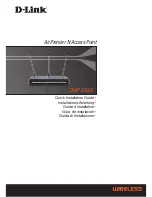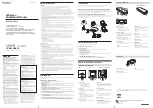
Chapter 16 The Status Screen
OX253P User
’
s Guide
165
Frequency
This field displays the radio frequency of the OX253P
’
s wireless
connection to a base station.
MAC address
This field displays the Media Access Control address of the OX253P.
Every network device has a unique MAC address which identifies it
across the network.
WiMAX State
This field displays the status of the OX253P
’
s current connection.
•
INIT
: the OX253P is starting up.
•
DL_SYN
: The OX253P is unable to connect to a base station.
•
RANGING
: the OX253P and the base station are transmitting and
receiving information about the distance between them. Ranging
allows the OX253P to use a lower transmission power level when
communicating with a nearby base station, and a higher
transmission power level when communicating with a distant base
station.
•
CAP_NEGO
: the OX253P and the base station are exchanging
information about their capabilities.
•
AUTH
: the OX253P and the base station are exchanging security
information.
•
REGIST
: the OX253P is registering with a RADIUS server.
•
OPERATIONAL
: the OX253P has successfully registered with the
base station. Traffic can now flow between the OX253P and the base
station.
•
IDLE
: the OX253P is in power saving mode, but can connect when a
base station alerts it that there is traffic waiting.
Bandwidth
This field shows the size of the bandwidth step the OX253P uses to
connect to a base station in megahertz (MHz).
CINR Mean
This field shows the average Carrier to Interference plus Noise Ratio of
the current connection. This value is an indication of overall radio signal
quality. A higher value indicates a higher signal quality, and a lower
value indicates a lower signal quality.
CINR Deviation
This field shows the amount of change in the CINR level. This value is
an indication of radio signal stability. A lower number indicates a more
stable signal, and a higher number indicates a less stable signal.
CINR Reuse 1
This field shows the WiMAX signal quality when the OX253P is
transmitting data to the base station. A higher value indicates a higher
signal quality, and a lower value indicates a lower signal quality. The
base station determines downlink (DL) and uplink (UL) modulations
based on this value.
RSSI
This field shows the Received Signal Strength Indication. This value is a
measurement of overall radio signal strength. A higher RSSI level
indicates a stronger signal, and a lower RSSI level indicates a weaker
signal.
A strong signal does not necessarily indicate a good signal: a strong
signal may have a low signal-to-noise ratio (SNR).
UL Data Rate
This field shows the number of data packets uploaded from the OX253P
to the base station each second.
Table 77
Status (continued)
LABEL
DESCRIPTION
Summary of Contents for OX253P
Page 9: ...Contents Overview OX253P User s Guide 10 ...
Page 16: ...17 PART I User s Guide ...
Page 17: ...18 ...
Page 21: ...Chapter 1 Getting Started OX253P User s Guide 22 ...
Page 27: ...Chapter 2 Introducing the Web Configurator OX253P User s Guide 28 ...
Page 44: ...45 PART II Technical Reference ...
Page 45: ...46 ...
Page 85: ...Chapter 8 The NAT Configuration Screens OX253P User s Guide 86 ...
Page 117: ...Chapter 10 The Certificates Screens OX253P User s Guide 118 ...
Page 127: ...Chapter 11 The Firewall Screens OX253P User s Guide 128 ...
Page 171: ...Chapter 16 The Status Screen OX253P User s Guide 172 ...
Page 179: ...Chapter 17 Troubleshooting OX253P User s Guide 180 ...
Page 183: ...Chapter 18 Product Specifications OX253P User s Guide 184 ...
Page 215: ...Appendix B Setting Up Your Computer s IP Address OX253P User s Guide 216 ...
Page 227: ...Appendix C Pop up Windows JavaScripts and Java Permissions OX253P User s Guide 228 ...
Page 278: ...Index OX253P User s Guide 279 ...
Page 279: ...Index OX253P User s Guide 280 ...
















































